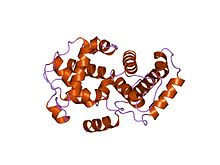Cyclin
| Cyclin, N-terminal domain | |||||||||
|---|---|---|---|---|---|---|---|---|---|

Structure of bovine cyclin A.
|
|||||||||
| Identifiers | |||||||||
| Symbol | Cyclin_N | ||||||||
| Pfam | PF00134 | ||||||||
| Pfam clan | CL0065 | ||||||||
| InterPro | IPR006671 | ||||||||
| PROSITE | PDOC00264 | ||||||||
| SCOP | 1vin | ||||||||
| SUPERFAMILY | 1vin | ||||||||
|
|||||||||
| Available protein structures: | |
|---|---|
| Pfam | structures |
| PDB | RCSB PDB; PDBe; PDBj |
| PDBsum | structure summary |
| Cyclin, C-terminal domain | |||||||||
|---|---|---|---|---|---|---|---|---|---|

Structure of CDK2-cyclin A/indirubin-5-sulphonate.
|
|||||||||
| Identifiers | |||||||||
| Symbol | Cyclin_C | ||||||||
| Pfam | PF02984 | ||||||||
| Pfam clan | CL0065 | ||||||||
| InterPro | IPR004367 | ||||||||
| PROSITE | PDOC00264 | ||||||||
| SCOP | 1vin | ||||||||
| SUPERFAMILY | 1vin | ||||||||
|
|||||||||
| Available protein structures: | |
|---|---|
| Pfam | structures |
| PDB | RCSB PDB; PDBe; PDBj |
| PDBsum | structure summary |
| K cyclin, C terminal | |||||||||
|---|---|---|---|---|---|---|---|---|---|

structure of a p18(ink4c)-cdk6-k-cyclin ternary complex
|
|||||||||
| Identifiers | |||||||||
| Symbol | K-cyclin_vir_C | ||||||||
| Pfam | PF09080 | ||||||||
| InterPro | IPR015164 | ||||||||
| SCOP | 1g3n | ||||||||
| SUPERFAMILY | 1g3n | ||||||||
|
|||||||||
| Available protein structures: | |
|---|---|
| Pfam | structures |
| PDB | RCSB PDB; PDBe; PDBj |
| PDBsum | structure summary |
Cyclins are a family of proteins that control the progression of cells through the cell cycle by activating cyclin-dependent kinase (Cdk) enzymes.
Cyclins were originally discovered by R. Timothy Hunt in 1982 while studying the cell cycle of sea urchins.
In an interview for "The Life Scientific" (aired on 13/12/2011) hosted by Jim Al-Khalili, R. Timothy Hunt explained that the name "cyclin" was originally named after his hobby cycling. It was only after the naming did its importance in the cell cycle become apparent. As it was appropriate the name stuck.R. Timothy Hunt: "By the way, the name cyclin, which I coined, was really a joke, it's because I liked cycling so much at the time, but they did come and go in the cell..."
Cyclins were originally named because their concentration varies in a cyclical fashion during the cell cycle. (Note that the cyclins are now classified according to their conserved cyclin box structure, and not all these cyclins alter in level through the cell cycle.) The oscillations of the cyclins, namely fluctuations in cyclin gene expression and destruction by the ubiquitin mediated proteasome pathway, induce oscillations in Cdk activity to drive the cell cycle. A cyclin forms a complex with Cdk, which begins to activate the Cdk, but the complete activation requires phosphorylation, as well. Complex formation results in activation of the Cdk active site. Cyclins themselves have no enzymatic activity but have binding sites for some substrates and target the Cdks to specific subcellular locations.
Cyclins, when bound with the dependent kinases, such as the p34/cdc2/cdk1 protein, form the maturation-promoting factor. MPFs activate other proteins through phosphorylation. These phosphorylated proteins, in turn, are responsible for specific events during cycle division such as microtubule formation and chromatin remodeling. Cyclins can be divided into four classes based on their behavior in the cell cycle of vertebrate somatic cells and yeast cells: G1 cyclins, G1/S cyclins, S cyclins, and M cyclins. This division is useful when talking about most cell cycles, but it is not universal as some cyclins have different functions or timing in different cell types.
...
Wikipedia
